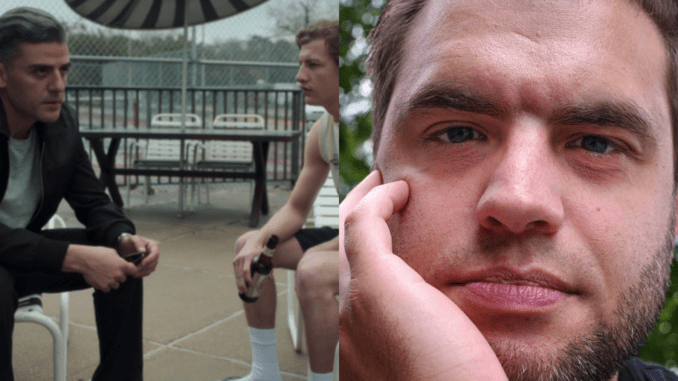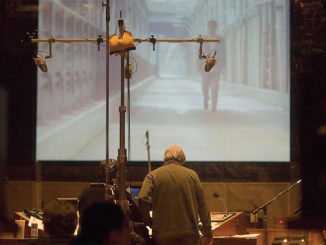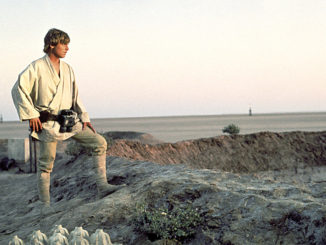
By Peter Tonguette
In some ways, filmmaker Paul Schrader and editor Benjamin Rodriguez Jr. make for the unlikeliest of longtime collaborators.
Schrader is an industry veteran — some would say a legend — whose screenwriting credits include “Taxi Driver” (1976), “Raging Bull” (1980), and “The Last Temptation of Christ” (1988), and whose directorial filmography is studded with stylish, daring films, among them “American Gigolo” (1980), “Mishima: A Life in Four Chapters” (1985), and, most recently, “First Reformed” (2017).
Rodriguez, who has been working with Schrader since the mid-2010s, is a comparative newcomer. The Cleveland native made his feature film debut as the editor on what was Schrader’s 19th directorial feature, the explosively original noir comedy “Dog Eat Dog” (2016), starring Nicolas Cage and Willem Dafoe. Having recently made a thriller that was altered in postproduction over his objections — “Dying of the Light” (2014), also starring Cage — Schrader insisted on final cut on “Dog Eat Dog,” and with his newfound freedom, was determined to install fresh talent in key creative posts.
That’s where Rodriguez came in.
“I don’t know any other director of his level, of his history, that would take these chances with younger people who deserve chances and are hungry for them,” Rodriguez said. “I just don’t know anybody else that would have had the courage to stand behind that.”
Schrader’s gamble on Rodriguez has paid off: Following the artistic, if not commercial, success of “Dog Eat Dog,” Rodriguez was tapped to edit the Academy Award-nominated “First Reformed,” an intimate, disciplined drama starring Ethan Hawke as a minister beset by spiritual and earthly torment; and a bold re-edit of “Dying of the Light,” which is unavailable to be viewed by the general public, “Dark”; and their latest film, a drama in the manner of “First Reformed,” “The Card Counter.”
“I understand how privileged I am to be working with Paul,” Rodriguez said.
Released by Focus Features on Sept. 10, “The Card Counter” stars Oscar Isaac as the ironically named William Tell, a former Army interrogator who, after completing a prison term for his complicity in War on Terror-era torture of prisoners, has remade himself as a gambler in flight from his former life. Co-starring Dafoe, Tiffany Haddish, and Tye Sheridan, the film is anchored by a brilliantly subtle performance by Isaac, whose character is the most recent incarnation of the traditional Schrader protagonist: troubled, tightly wound men beset by demons.
“It’s all in the vein of Schrader’s whole career: these man-in-a-room pictures,” Rodriguez said.
Since its debut at the Venice Film Festival earlier this month, “The Card Counter” has received laudatory reviews, but the film had a long, winding, and pandemic-specific journey to the screen: The production was about 85 % complete when the coronavirus hit in the United States in March of 2020. The remaining five days of shooting were put on hold and did not resume until last summer.
Drawing on the shorthand they established on their earlier films, though, Schrader and Rodriguez managed to complete postproduction remotely. “Paul was in upstate New York, and I’m in New Jersey,” Rodriguez said. “Of course, I wanted to be protective and careful. Paul originally thought that maybe we could get together for a few weeks, but he has chronic asthma and breathing issues, and he’s an older gentleman. I just didn’t want to be the one that brought anything to him, so it was just safer to kind of stay apart.”
Using Evercast, though, Rodriguez could keep tabs on Schrader’s reactions to how the film was coming together as well as to specific scenes. For example, while viewing Rodriguez’s assembly of one scene, the editor noted that his director was having a favorable response just by looking at him. “It was great because I could watch him on the video feed from Evercast, and he was smiling through it,” Rodriguez said.
How did the old veteran and hungry newcomer get together in the first place?
An avid film fan since childhood, Rodriguez entered the Cleveland Institute of Art in 2000. He was first interested in photography. “Then the school brought in a new digital arts major, and one of the areas of focus was digital filmmaking,” Rodriguez said. “This was when Final Cut was coming around, which is the first editing software I learned.”
Following graduation in 2005, Rodriguez tried to get a foothold in local film production. “I tried to do stuff in my field in Ohio, which was very limiting,” he said. “I ended up getting some other jobs, but not in the field at all.” Then, encouraged by a professor to return to the Cleveland Institute of Art as a technical advisor, that same professor suggested that he attend film school. “She was very persistent,” he said. “She really believed in my work and that I needed to do this.”
In 2007, Rodriguez and his wife moved to New York City — his father’s hometown — to attend the graduate film program at New York University Tisch School of the Arts, where his class included directors Shaka King and Chloé Zhao. His focus shifted from cinematography to editing, and after leaving school, he was accepted as an intern at Lost Planet Editorial, a commercial editing firm owned by editor Hank Corwin, ACE.
“I knew of Hank Corwin’s work on ‘JFK,’ ‘Natural Born Killers,’ and ‘Nixon,’ and all of the other films he had done with Oliver Stone,” said Rodriguez, who quickly rose to become an assistant editor at the company. “The company changed everything for me. It just opened my eyes creatively in so many ways.”
Rodriguez came into Schrader’s orbit after editor Jay Rabinowitz, ACE — who Rodriguez had assisted on commercials at Lost Planet — received an email from Schrader, with whom he had worked on the film “Affliction” (1997), with a request for suggestions for young, up-and-coming editors to cut his new film, “Dog Eat Dog.”
“Jay sent me an email and said, ‘What do you think?’” Rodriguez remembered. “Of course, I was in awe of ‘Taxi Driver’ and the early films that he had done with Scorsese. I just couldn’t believe that someone of his stature would be interested in working with someone who had never cut a feature before.”
Rodriguez, who had never cut a feature before and had assumed his first such opportunity might come from classmates at NYU who themselves would be making their first film, found himself taking a meeting with Schrader at the director’s go-to meal spot, the Rail Line Diner.
“We hit it off instantly,” Rodriguez said. “He said he was really interested in doing this unconventionally and was looking for young key crew members who were outside of the box and came from very different backgrounds than a traditional, established editor that had been in the game.”
Soon, Rodriguez found himself in Cleveland — where, fortuitously, “Dog Eat Dog” was being shot — working with one of America’s premier writer-directors. But he wasn’t nervous. He knew Schrader would give him a free hand. The director, unnerved by the recent experience on “Dying of the Light,” had won final cut and was, as the editor put it, “going to take full advantage of it.”
“Paul made it so comfortable,” he said. “He encouraged me just to play. I really didn’t feel pressure to abide by ‘Don’t cross the line here’ or whatever. I would just go off my intuition.”
With its unhurried rhythm and contemplative tone, their next film, “First Reformed,” demanded far more editorial discipline from Rodriguez, but he found himself embracing the challenge. “It was fun having the freedom on ‘Dog Eat Dog,’ but I was really hungry to do something that was going to be challenging because of how confined and structured it was — a sort of throwback to early cinema,” he said. The film was Schrader’s most acclaimed in years.
“The Card Counter” adopts the same austere, rigorous aesthetic of “First Reformed,” unfolding in large part in long, languorous shots that invite the audience to contemplate the soul of Isaac’s character, the enigmatic William Tell.
“The film was in the same vein of ‘First Reformed,’” Rodriguez said. “Paul and I talked about length of shots, holding on shots. He’s started to do less and less coverage. He limits his coverage just to help him make his day, but he thinks about that in terms of the tone of the film.”
Although a few individual scenes were eliminated as the film took shape, Rodriguez’s task mostly consisted of shaping what was already there: honoring the film’s deliberate pace while also holding the audience’s attention. “Paul has to shoot these movies quickly,” Rodriguez said. “But he’s been doing it for so long that he does a lot of editing in his head on the set.” As Rodriguez sees it, his job on “The Card Counter” often involved “looking at the nuances of the performances, slight shifts in the behavior that could project something that has a totally different feeling about the characters.”
Equal care was given to the film’s sound world: The narration spoken by Isaac was dropped into the film as a piece of music might. “Voiceover placements are always very important,” Rodriguez said, “and rewriting the voiceovers that need to be rewritten.” Songs by composer Robert Levon Been were integrated gradually into the film, with the audience first hearing unintelligible excerpts from Been’s music — moans, grunts, and breathing — before later scenes feature whole lyrics and still later scenes feature whole songs. “The emotion and the texture that they add to the story works very well,” Rodriguez said.
More aesthetically jarring are flashbacks to Tell’s days as an interrogator, which were photographed using the same ultra-wide lenses used in VR footage. The distorting effect gave the scenes the quality of a nightmare. “It’s like the widest lens ever,” Rodriguez said. “Paul wanted it to be different and not realistic because it is a memory/dream. He always saw it as this one, long Steadicam shot. There was talk about pushing the distortion effect even further, but we just were really happy with how it came out.”
It all sounds so simple: You meet Paul Schrader, hit it off with him, cut one movie for him, then another, then another. And yet Rodriguez does not take any of it for granted. “For Paul, I think people who are young or new or inexperienced will give a fresh idea,” he reflected. “I understand that this working relationship with Paul isn’t going to last forever, and I know what I’m a part of with him. I’m just so grateful.”
# # #






